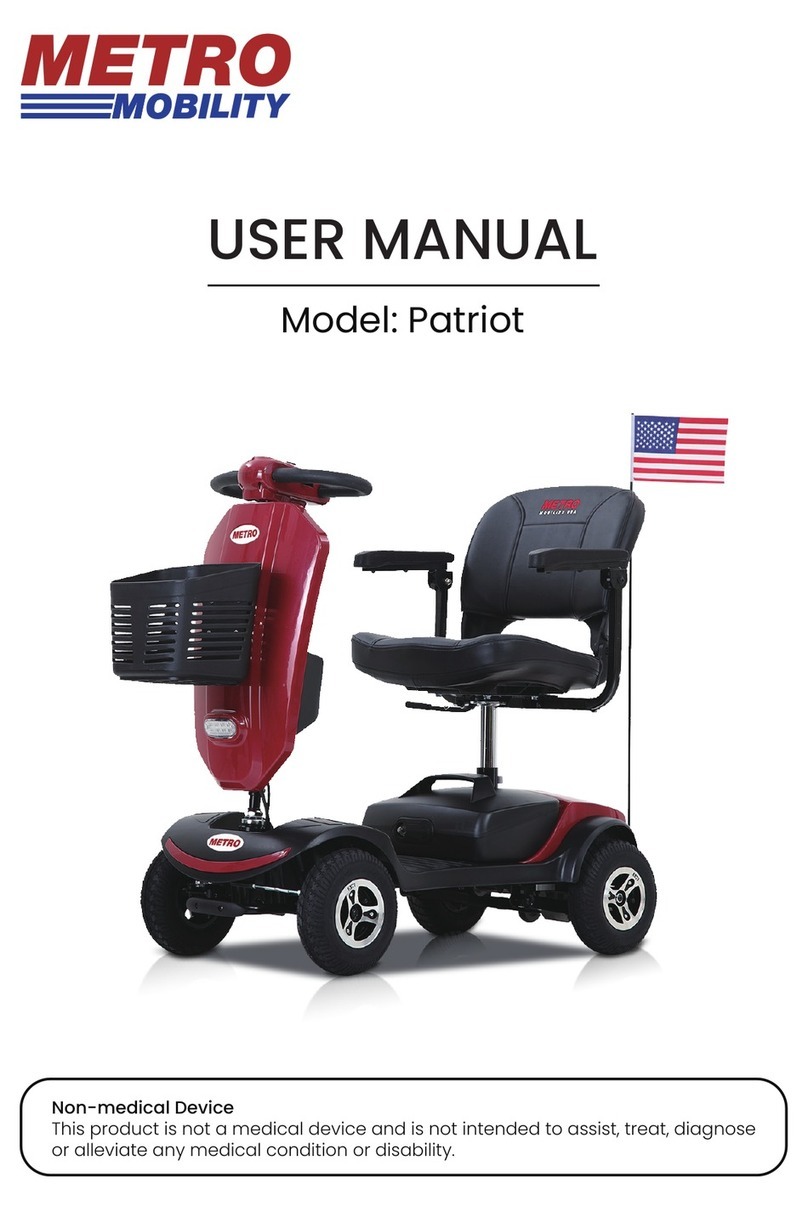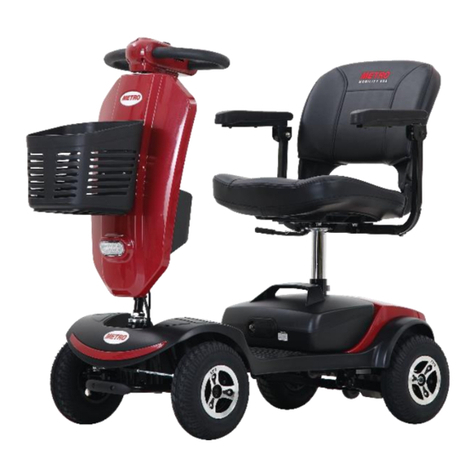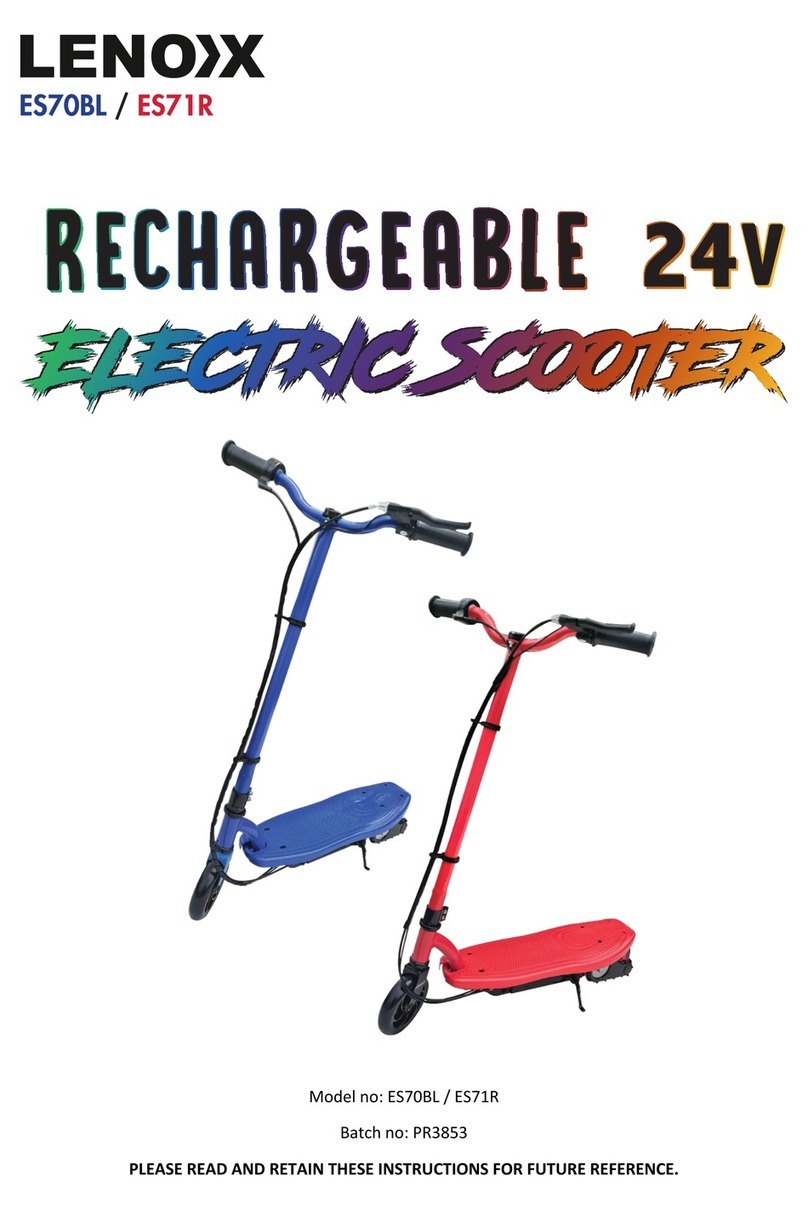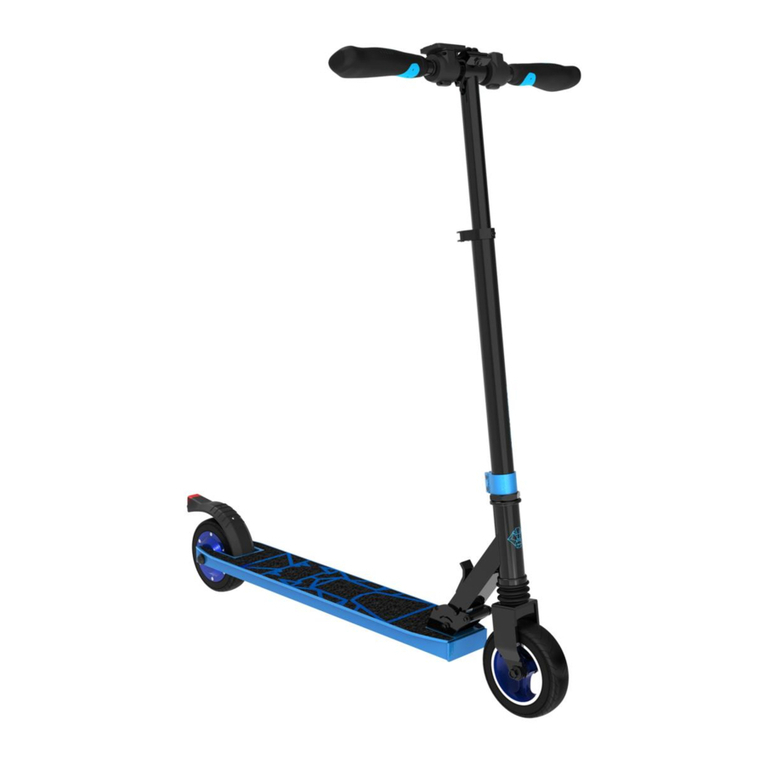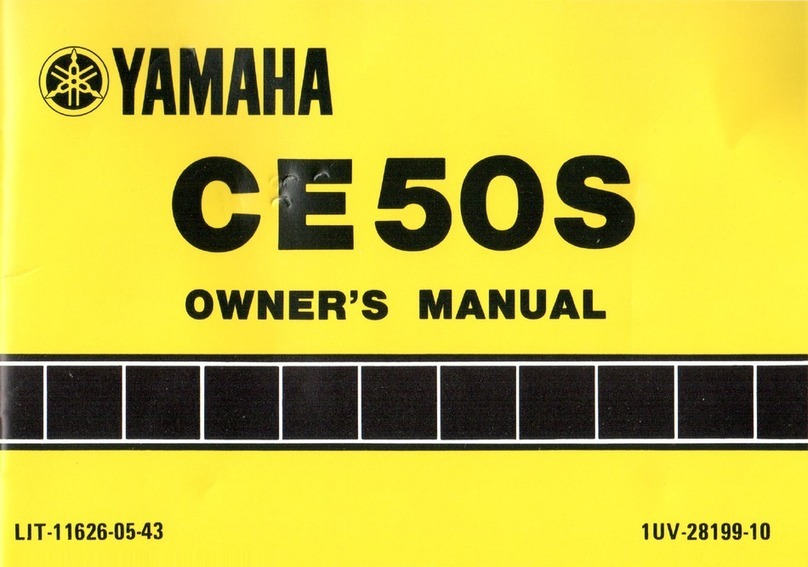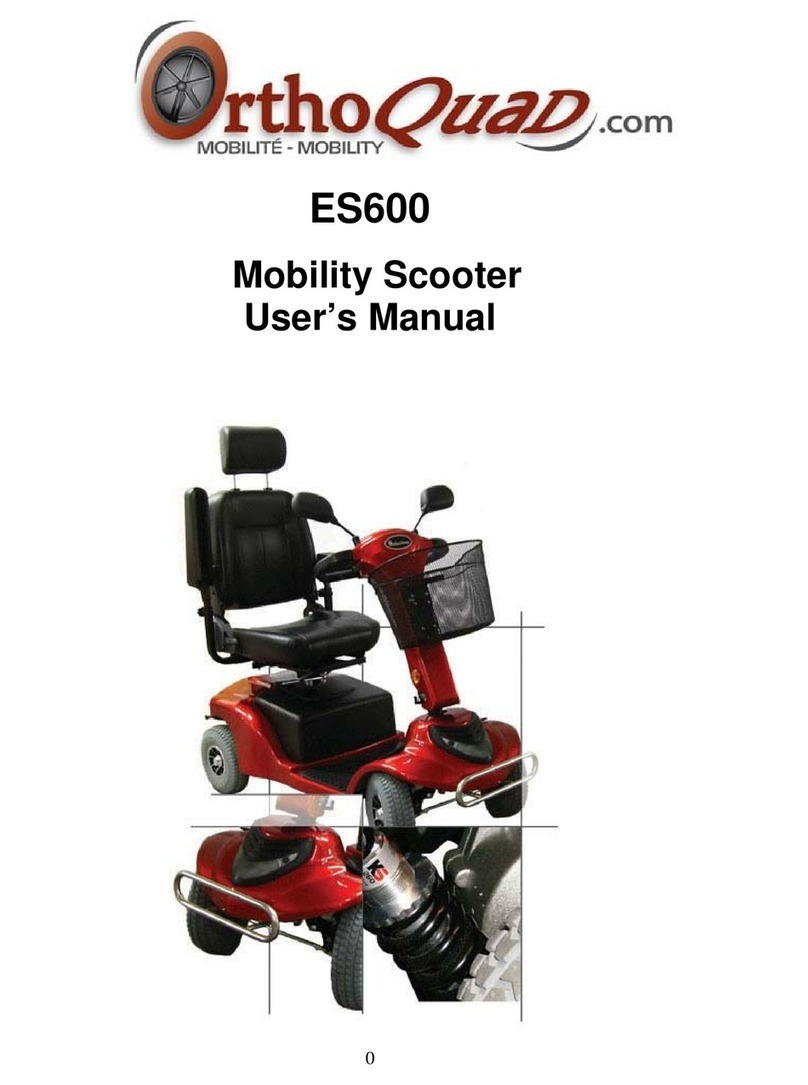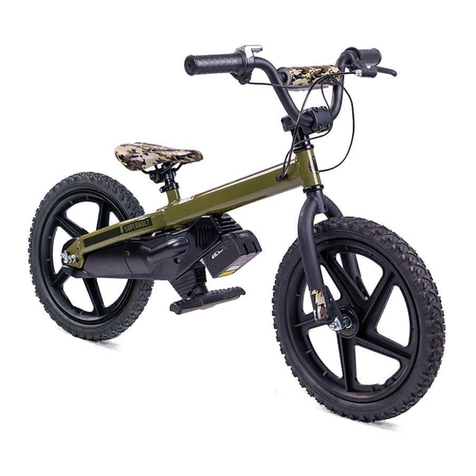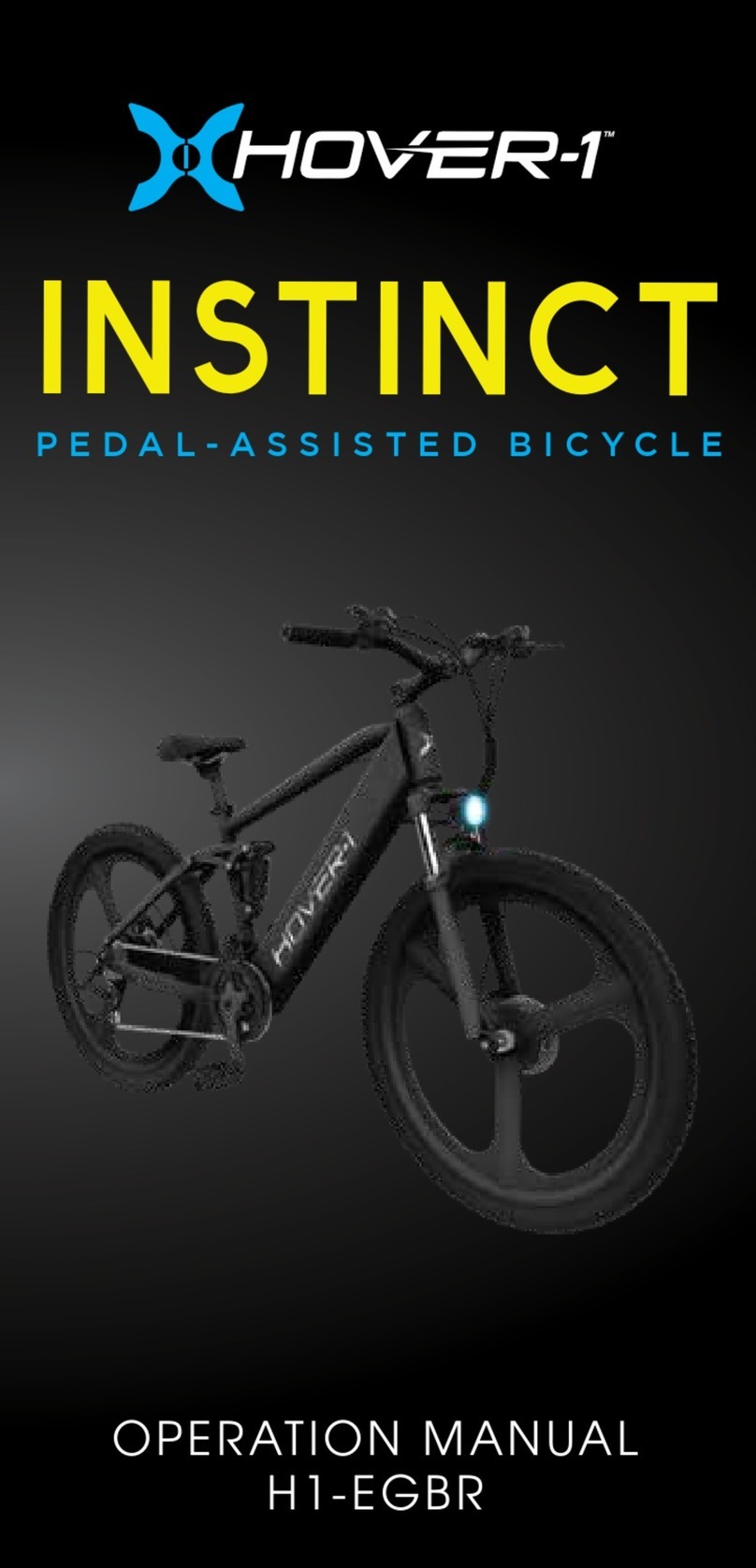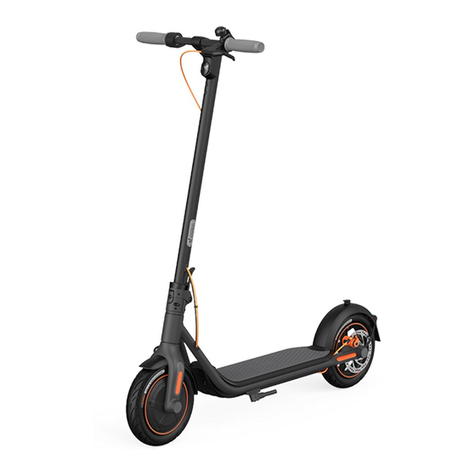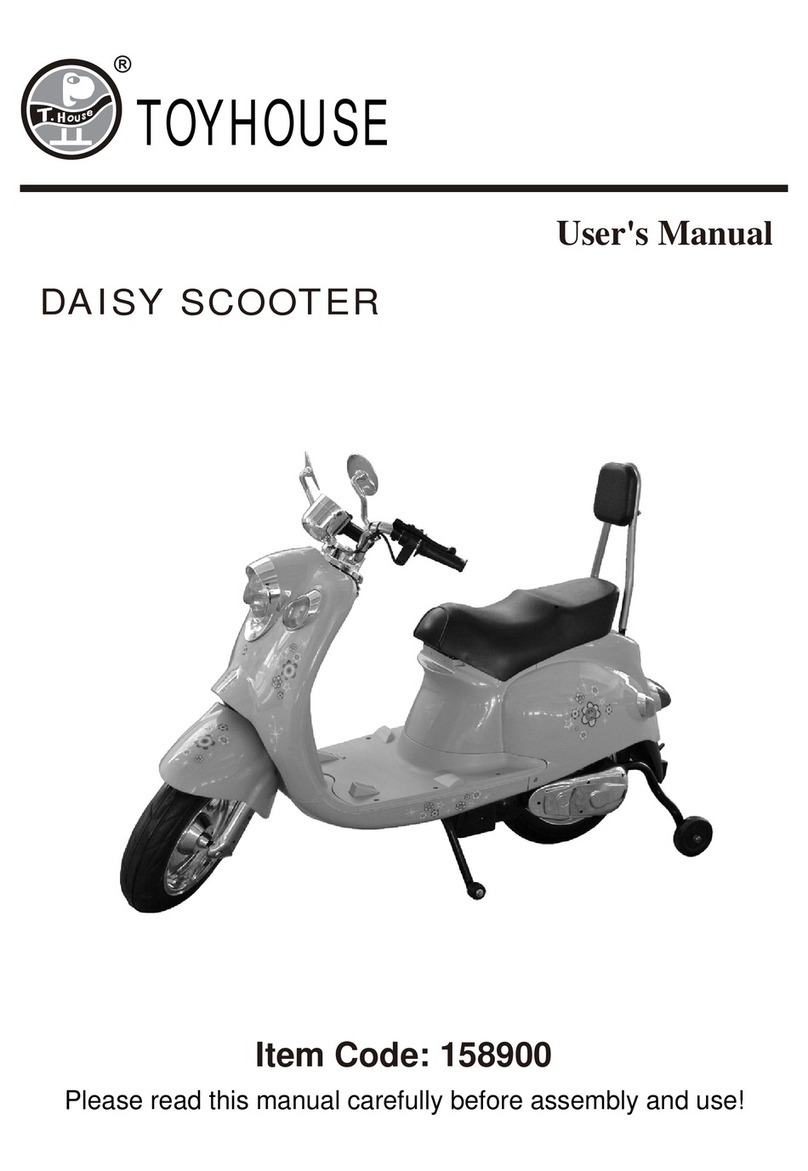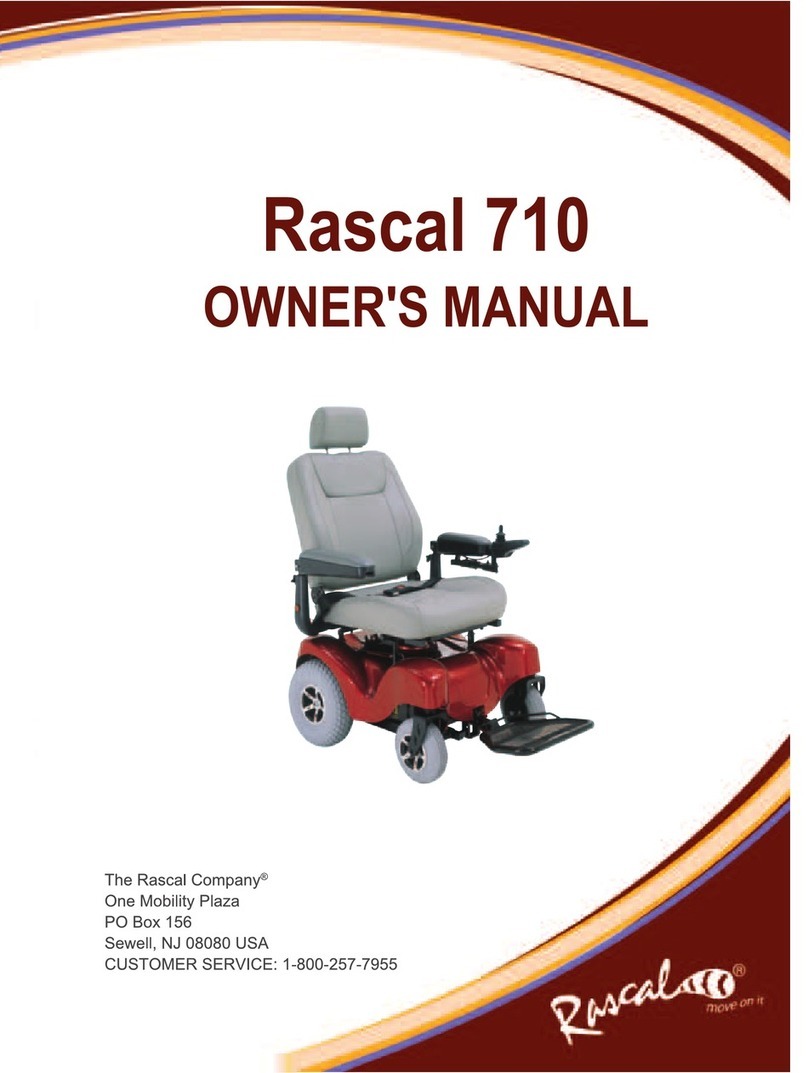Metro Mobility S800 User manual

Owner’s Manual
(S800)

CONTENTS
1. SAFETY INSTRUCTION1
2. ELECTOMAGNETIC INTERFERENCE (EMI) 6
3. SPECIFICATIONS7
4. COMFORT ADJUSTMENT8
5. FEATURES11
6. GETTING ON & OFF THE SCOOTER12
7. OPERATION OF TILLER CONTROL 13
8. CHARGING INSTRUCTIONS16
9. BATTERY INSTRUCTIONS & MAINTANENCE19
10. SCOOTER MAINTENANCE 20
11. TRANSPORTATION21
12. TROUBLESHOOTING & FAULT REPAIR22
13. WARRANTY DECLARATION24

SAFETY INSTRUCTION
Distinguished guests, please read this manual carefully before
using the scooter for the understanding of the precautions and
scooter performance. Failure to follow the instructions may lead to
scooter damage or serious personal injury.
1. Please obey local traffic regulations when using the product.
2. Do not try to refit the scooter without permission or use the scooter for other purpose.
3. In the event you feel dizzy, your vision is blurred due to health condition or medication,
please must not operate the scooter.
4. Consult your physician if you are taking prescribed medication or if you have any certain
physical limitations. Some medications and limitations may impair your ability to operate
scooters in a safe manner.
5. Drunk driving is strictly prohibited in the any area.
6. Please check the brake system before driving the scooter.
7. Do not set the electric switch OFF before the scooter stops stably on smooth ground.
8. Don't remove anti-tipper wheel if the scooter is equipped with it.
9. Do not stop the scooter when climbing a slope or drive on the slope steeper than the
limitation for the stability of the scooter and your safety.
10. Please ride with caution and keep a safe distance on the road with rain, oil and snow to
prevent tires from slipping and rollover.
11. Please slow down and be careful when turning or reversing.
12. Please do not use the music entertainment system when driving the scooter, for it may
cause distraction and traffic accident.
13. Please do not overload.
14. Please power off the scooter when it is not in use to prolong the service life of the battery
and protects you from accident.
15. Please do not charge under the exposure of sun in the summer charge the battery indoors in
winter when the outdoor temperature is lower than 10℃.
About Modifications
We have designed and engineered the power scooter for the maximum service life. However, under no
circumstances should you modify, add, remove, or damage any part or function of the power scooter,
otherwise, personal injury and damage to the mobility scooter may result in. Please use original
accessories provided by us, untested or inapplicable accessories may lead to the breakdown.
Inspections prior to using your power scooter

1. If the scooter is equipped with pneumatic tires, proper tire pressure should be ensured before using it.
2. Please check all electric connections and make sure they are well connected and undamaged.
3. Please check all the harness connections and make sure that they are secured properly.
4. Please check the brake system and make sure that they are in good condition.
Load limitation
1. Please refer to the specifications table for weight capacity information. Mobility scooter is limited for
a maximum weight capacity.
2. Stay within the specified weight capacity for your scooter. Overload will make your warranty void
and we will not take responsibility for your injuries or property damage resulting from failures to
observe weight limitation rules.
3. Don't carry passengers on the scooter designed only for one driver. Carrying passengers on the
scooter may result in the change of the gravity center, and finally may causes rollover or tilt.
Tire pressure
1. If your scooter is equipped with pneumatic tires, it is necessary to check the air pressure at least one
time a week.
2. Proper inflation pressures will prolong the life your tires and ensure the smooth operation while
riding.
3. Do not under-inflate or over-inflate your tires. It is critically important that 30-25 psi (2-2.4bar) tire
pressure be maintained in pneumatic tires at all times.
4. Inflating your tires from an unregulated air source could over-inflate them, resulting in a burs tire.
Temperature
1. Some parts of the mobility scooter are susceptible to changes of temperature. The controller can only
operate safely between -25℃and 50℃.
2. The batteries may freeze at extremely low temperature, and your mobility scooter may not be able to
run at such low temperature. If at extremely high temperatures, it may operate at lower speed due to a
safety feature of the controller that prevents the motor and other electrical components from
damages.

ELECTROMAGNETIC INTERFERENCE (EMI)
The rapid development of electronic technology, especially in the area of communications, has saturated
our environment with electromagnetic (EM) radio waves that are emitted by television, radio and
communication signals. These EM wave is invisible and their intensity increases as source increase. All
electrical conductors act as antennas to the EM signals and to varying degrees, all the power wheelchairs
and scooters are susceptible to electromagnetic interference (EMI). The interference could result in
abnormal, unintentional movement and/or erratic control of the vehicle. The United States Food and
drug Administration (FDA) suggests that the following statement be incorporated to the user's manual for
all scooters like S800. Mobility scooters may as susceptible to electromagnetic interference (EMI), which
is interfering electromagnetic energy emitted from sources such as radio stations, TV stations, amateur
radio (HAN) transmitter, two-way radios, cellular phones and alarm systems of shops. The interference
(from radio wave sources) can make the scooter release its brakes, move by itself or move in unintended
directions. It may also permanently damage the scooter's control system. The intensity of the EM energy
can be measured in volts per meter (V/m). Each scooter can resist EMI up to a certain intensity, which is
called interference resistance capacity, and the scooter has an interference resistance capacity of 20 v/m
which would provide useful protection against common sources of radiated EMI.
the warnings listed below can reduce unintended brake release or uncontrolled move that may result in
serious injuries:
1. Do not use portable CB transceiver or communication device like cell phone when the scooter is
started.
2. Be careful and stay away from electromagnetic wave release equipment like radio, TV station, or
etc.
3. If unintended movement or brake release occurs, turn the powered scooter off as soon as it is safe.
4. Be aware that adding accessories or components, or refitting the scooter may make it more
susceptible to interference from radio wave sources (Note: It is difficult to evaluate the effect on the
overall interference resistance capacity of the mobility scooter).
5. Please report all the incidents of unintended movement or brake release to the manufacturer of the
mobility scooter and note whether there is radio wave source nearby.

TECHNICAL SPECIFICATIONS
MODEL
S800
OVERALL LENGTH
1460mm
OVERALL WIDTH
730mm
OVERALL HEIGHT
1320mm
WEIGHT: W/ BATTERY
124kg
WEIGHT: W/O BATTERY
97kg
MAX. LOAD
180kg/1per
MAX. SPEED forward
15km/h
MIN. SPEED forward
4km/h
REVERSE SPEED
4km/h
TURNING RADIUS
2200mm
NARROWEST FOR TURNNING
2500mm
MAX.DRIVING SLOPE
12°
MAX.DRIVING RANGE
40±5km
DRIVING SYSTEM
Rear wheel with gear box
BRAKE SYSTEM
Intelligent electromagnetic brake
MOTOR
24V/800W
CONTROLLER
24V/140A
FRONT TIRE SIZE
13” * 5”
REAR TIRE SIZE
13” * 5”
BATTERIES
Lead-acid 12V/52AH *2pcs (75AH*2pcs)
CHARGER
AC 115/230V DC 24V 5A
MAX. CHARGING CURRENT
5A
CHARGING TIME to 80% charge
8h
CHARGING TIME to full charge
10h
SEAT WIDTH
500mm
SEAT DEPTH
480mm
SEAT HEIGHT from leg platform
490mm
BACKREST HEIGHT
660mm
ARMREST HEIGHT from seat
290mm
GROUND CLEARANCE
90mm
* Measurements above are for reference only.

COMFORT ADJUSTMENT
Adjustments for seating comfort
Turn the swivel lever forward to Push the front lever forward or backward
rotate the seat. to move the seat forward or backward.
The flip-up armrest height
can be adjusted by turning
the adjustment dial.
Adjust the seat back lever
for seating back angle.

Adjustment of tiller position
16. Press down the lever and move it to your preferred position.

FEATURES
Headlight
Headlight
Basket
Shortage compartment
Control panel
Flip-up armrest
Adjustable seat
Tire
Foot pedal
Adjustable backrest
Reflector mirror

GETTING ON & OFF THE SCOOTER
Getting on your scooter
1.Make sure that the key switch stays on “power off” position before getting on the scooter.
2. Turn the seat swivel lever located under the seat to make you feel comfortable and rotate the seat to
face forward.
3. Put down the armrests and use them to steady yourself into the seat.
4. Make sure that your feet are placed firmly on the foot pedal and the seat you seated is secure and
steady.
Getting off your scooter
1.Ride the scooter to a suitable place for parking the scooter and turn the key switch to “power off “.
2. Turn the seat swivel lever located under the seat backward and rotate the seat 90 degrees if the user
need to get off the scooter to a wheelchair.
3.Otherwise, you should put both feet on the ground and leave the seat by holding the armrests to leave
the seat.

OPERATION OF TILLER CONTROL
Key switch
Power off Power on
Control Panel
Left indicator light button Right indicator light button
Headlight button Warning signal light
Horn button Horn button
Speed control knob
Function
Speed Control Knob
Turn this knob to the left can slow down. Turning it to the right can speed up.
Headlight Button
Press the light button to turn on the lights in the dark or in the case of bad visibility and pressing it again
can switch off the light.

Horn Button
Pressing the horn button to alert pedestrians and vehicle of your presence when necessary.
Left/right Indicator Light Button
Press the button to show that your scooter is about to change direction.
Liquid Crystal Display(LCD)
Turn left Temperature LOGO Turn right
H/L Speed Alarm
Forward/backward Speed
Driving range
Power status
Running time
Functions
Power status: battery remaining capacity and charging indicator (5 squares battery icon+ voltage)
Speed sensor: 2.5 digits + 1 decimal + "km/h " symbol
High/low speed indicator: “H speed” or “Low speed” symbol
Forward/backward indicator: or symbol
Turn left/right indicator: or symbol
Odometer: driving range (99.9km max)
Running time: running time consumed per use
Temperature gauge: ºC mode
Malfunction code: READY symbol flashing
LCD back light: blue

Joystick
Move forward Move backward
For driving, please pull the right joystick (forward) or the left joystick (backward).
If you release the joystick, you can stop the scooter. In the center position the intelligent
electromagnetic brake system works also as a parking brake.
For the sake of safety, when rolling down the slope with the manual brake free, the intelligent brake
will work automatically if the running speed is more than 30% of the scooter's maximum speed.
Engaged Disengaged
Please be noted that the scooter will be at brake-free mode, when the manual brake is disengaged.
To use the manual brake, you must move and lock the lever behind to the engaged position!

CHARGING INTRUCTIONS
Appearance & Dimensions

Specifications
Item
Off-board Battery Charger
Model
HP8204B
Efficiency
81% min.
Output Current
5A±0.2A max.
Output Voltage
29.8V±0.2V max.
Floating Voltage
31.2V±0.2V
Input Current
2.7A max.
Input Voltage
115Vac/230Vac 50/60HZ
Pulsating Current
0~5A
Protection
1. Over-current protection
2. Over-voltage protection
3. Reverse power protection
4. Short circuit protection
LED Indicator
Red: power on
Orange: charging
Green: full charged
Operating Temperature
0℃~40℃
Operating Humidity
20%~85%
Operating Height
0~2000m
Measure
L 180mm×W 93mm×H 53mm
Weight
0.83kg
Color
Black
* The charger can choose to work via 230V or 110V by switching the charger off and sliding the red
tab on the end of the charger to the required setting by small screwdriver. The default setting is 230V.

Operating Instruction
1. Switch your scooter off with the key switch.
1. Swivel the charge connector cover on the tiller and
plug in.
2. Connect the other end with the battery.
3. Start to charge for the scooter.
Caution
Before using the battery charger, please read all the instructions carefully.
Please do not charge for the scooter outdoors, in confined space, or under the environment of high
temperature, flammability gas, oil fog and vapor. Please do not place the charger in the seat cask or
trunk when charging.
Ensure the scooter is switched off before charging.
Ensure that the charger plug is dry and intact before connecting with scooter.
After charging, please remember to swivel back the charging cover to avoid dampening.
The charger must be kept dry in the environment between -25°C and 40°C.
Use only the original charger from our company. Other brand charger may shorten your warranty
period, and unknown charger may cause damage and injury.
In all cases, the charger must only be repaired by an authorized dealer.
Tip
If some failure occurs, the reset button will pop out. Switch the scooter
off, press the button in and switch on the scooter again.
If your scooter fails to respond to normal control after a charging period,
please check whether the battery charger has been completely
disconnected from the scooter.

BATTERY INSTRUCTIONS & MAINTANENCE
Battery pack care plan
Battery should be compatible to the scooter and with match charger, no mix use is allowed.
The battery shall be checked whether it has been damaged, cracked, and whether the battery surface
is clean before use.
A new battery will achieve the best performance after 2or 3 complete cycles of charge and discharge.
If batteries keep unused for more than a month, it will lose about 5% of capacity.
Do not leave the charger connected with the batteries when the mains socket/plug is switched off.
In the event of a short circuit, the battery management system will switch to protect mode, and the
power cord in tandem with safety piece will fuse to give a double protect to battery. Once the fault is
removed, the battery can work normally.
If you leave your scooter for an extended period (more than 5 days), please charge your batteries for
12 hours, then remove charger and ensure the batteries are disconnected.
If the battery need to be stored, you should disconnect the battery with charging equipment and the
connection part of the load, it should be kept in cool, clean room. And you should conduct a
supplementary power every 3 months during shortage.
Please do not dispose of the battery out of use at will for the sake of environmental protection.
Caution
Remember to remove the plug from your scooter when charger is off, to prevent driving away whilst
attached. The scooter cannot be operated when being charged.
The batteries need to be checked regularly for signs of damage. If any damage is apparent, contact
your local mobility dealer immediately.
Take care not to short circuit the battery terminals. Remove all conductive jewelry (e.g. watches,
necklaces etc.) before checking the batteries.
When charging always place on a hard surface in a room with good ventilation. You should not
charge the batteries in outdoor conditions.
Do not expose any part of the battery to direct heat (i.e. gas fires or naked flame).
Do not allow the batteries to freeze.
Do not dispose of batteries in normal waste. Always recycle in accordance with local laws.
Tip
If you ride the scooter with low battery capacity and not be able to charge in time, the driving range can
be increased slightly by decelerating the maximum available speed.

SCOOTER MAINTENANCE
Proper routine maintenance of S800 can prolong its service life and check out the potential problems that
may affect the running and performance of the scooter, regular items that required are listed as follows:
ROUTINE MAINTENANCE
1. Keep the scooter free of dust, dirt and liquids. To clean the product, use a cloth dampened with warm
soapy water. Do not use chemicals, solvents or abrasive cleaners, as this may cause damage to the
product.
2. Monthly check all vehicle components for loose, damaged or corroded components, such as
connectors, terminals, or cables. Restrain all cables to protect them from damage. Replace damaged
components.
3. Check the tire pressure and the degree of wear regularly to see whether they need to be changed.
4. Check the seat whether it is loose or shakes sharply before riding.
5. Check whether the electromagnetic brake meets the brake requirements, and the scooter can be
placed on the appropriate slope for further inspection;
6. Check the motor to see whether it need to be replaced, especially after being used for one year.
7. Please develop good driving habits, and operate the scooter beyond the permitted range.
8. The scooter should be stored in the dry and ventilated place. Please do not place it in the water or
very damp environment (humidity should be less than 85%).
9. If the scooter has not been used for a long time, please check the battery condition and keep the
battery full charged and charge for it at least once a month.

PACKAGING & TRANSPORTATION
The scooter S800 can be disassembled into several parts quickly and simply for packaging and
transportation, and you need to do as follows:
1. Switch off the scooter, and make sure the motor is engaged.
2. Disassemble the scooter into packed parts and put it into the packing box for transportation.
Caution
Please secure your scooter parts before transportation. Do not sit on your scooter when it is being
transported in or on another vehicle.
Packaging and Transportation Environment Conditions
The mobility scooters can be transported by common transportation vehicles, but you need to prevent
them from serious collision, vibrating or exposing in the snow or rain.
The packaged scooters should be placed in an environment with good ventilation between -20℃~45℃,
humidity should be less than 93%.

TROUBLESHOOTING & FAULT REPAIR
Failures
Possible causes
Solutions
Driving range shorten
Batteries not charged for enough time
Charge batteries for eight
hours or more
Batteries is aging to low capacity
Replace batteries
Battery cannot charge or
battery gauge shows
empty after charging
Battery fault
Replace batteries
Charge fault
Contact with local dealer
Charger plug damaged
Check plug
Loose connection
Try a wall socket in a
different room
No output from wall outlet
Unplug from wall & change
fuse
Fuse in charger mains plug blown
Switch off and press button
back in
Button on battery pack has popped
out
Switch off and press button
back in
Output fuse in charger blown
Unplug from wall and
contact dealer
Battery charging current
high
Battery fault
Replace batteries
Scooter switched on during charging
switch off the scooter
The scooter cannot
work
Brake-release lever disengaged
Engage brake-release lever
Flat batteries
Charge battery pack
Scooter is not switched on with key
switch
Ensure the key switch is
switched on
The battery cable is loose.
Check battery cable
Charger plugged in
Unplug charger
Button on battery pack popped out
Reset circuit-breaker button
Disconnected loom or plugs
Check all plugs & looms
Control system fault
Contact with dealer
Motor runs irregularly
and/or noisily
Electrical malfunction
Contact with dealer
Control system fault
Contact with dealer
* Do not attempt to disassemble any parts of the scooter control system, battery or battery
charger.
* The control system is critically important and user should not deal with it arbitrarily.
Table of contents
Other Metro Mobility Scooter manuals
